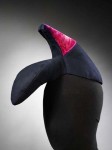The new expedition to fully map and record the wreck of the Titanic has had to repair to St. John’s, Newfoundland temporarily to avoid getting whupped by Hurricane Danielle. Inclement weather notwithstanding, the team has already captured impressive new 3DHD footage of various parts of the wreck.
Here’s the famous bow so goofily captured by James “King of the World” Cameron (in real life passengers weren’t allowed anywhere near the bow):
[flashvideo file=http://www.thehistoryblog.com/wp-content/videos/bow.flv /]
Amazing, isn’t it? That footage was taken at 3820 meters under the sea. The 3DHD technology takes much sharper pictures even at murky depths, and although we don’t get to see the full impact like the team members did when they got to view the complete footage with 3D glasses, the colors and definition are astonishing.
The expedition website is already packed with new footage, pictures and a Flash-based map you can click and drag around to explore the wreck and debris field. Click on everything, seriously, because it’s all fascinating.
I think my favorite may be Captain Smith’s stateroom, because you can see his bathtub through the collapsed walls. When Titanic was first discovered in 1985, the Captain’s stateroom was in fairly solid condition. Over the past 25 years, corrosion has buckled the walls and is beginning to eat away at the roof.
Biodegredation is a major concern. Colonies of microorganisms have been actively gnoshing on Titanic’s iron, producing long ribbons of digested metal called rusticles (like icicles only made out of rust). It seems very likely at this point that the different floors in the stern of the ship, the part of the wreck with the greatest bacterial activity, will sooner or later fully collapse onto each other. The iron in the stern was put under the greatest amount of stress during the sinking of the Titanic which makes it more susceptible to rusticle formation now, and all food was stored there, which experts think may have acted as lure and sustenance for microbes.
That’s what makes this project so important. We’ll not only have a detail-rich big picture of Titanic’s current condition, but we’ll have a greater understanding of the wreck’s long-term prospects.
RMS Titanic’s Facebook page is another rich source of pictures and minute-to-minute information about the project.







